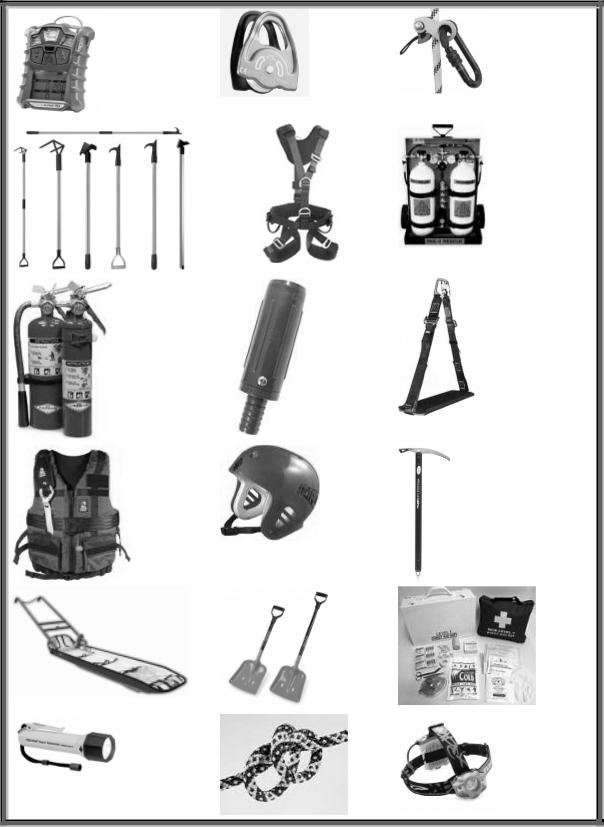
Англ. яз. для специалистов по защите окружающей среды и бж
.pdfPhases |
Aims |
|
|
Measures |
|
Mitigation |
|
|
|
|
technological solutions, leg- |
|
|
|
|
|
islation, land-use planning, |
|
|
|
|
|
regulations regarding evacua- |
|
|
|
|
|
tion, communication of risks |
|
|
|
|
|
to the public. |
Preparedness |
to |
|
capabilities |
of |
|
|
organizations to prevent, pro- |
|
|||
|
|
improve |
|
|
|
|
tect against, respond to, |
re- |
|
||
|
|
|
natural disasters, |
|
|
|
acts of terrorism, and other |
|
|||
|
cover from |
|
|
|
|
|
man-made disasters |
|
|
||
Response |
|
|
|
|
mobilization of the necessary |
|
|
|
|
|
emergency services and first |
|
|
|
|
|
responders such as firefight- |
|
|
|
|
|
ers, police and ambulance |
|
|
|
|
|
crews |
Recovery |
|
|
|
|
|
|
|
|
|
|
|
14.Fill in prepositions if they are needed.
To reduce _________ hazards; to prevent _______ fires;
to protect _________ flooding;
to provide ________ efficient tools; to respond ________ emergency; to recover ________ disaster.
15.Use the table in Activity 13 to speak about the phases of emergency management.
16.Read the text SUGAR REFINERY TRAINS FOR EMERGENCY RESPONSE and answer the questions.
1.What is ICS and what are its functions?
2.What are the duties of incident commander?
3.Who serves as an incident commander at an industrial enterprise?
4.What specialists are involved in ICS?
5.What are the three levels of emergency severity?
6.What is the role of police in case of technological incident? SUGAR REFINERY TRAINS FOR EMERGENCY RESPONSE
Ever wondered how a factory or processing plant goes about handling an emergency such as a fire or chemical spill? That was the focus of initial training recently begun at Imperial Sugar Company’s sugar refinery in Gramercy, Louisiana.
OSHA (Occupational Health and Safety Administration) requires organizations that potentially have to respond to emergencies involving hazardous materials. For this purpose a nationally recognized incident command system or ICS is organised. It presents a systematic approach that uses a standardized and unified command structure to safely mitigate emergencies.
Key elements of an incident command system include:
•standard terminology;
•modular organization;
•pre-designated incident facility;
•integrated communications;
•unified command structure;
•consolidated plan-of-action;
•comprehensive resource management.
Marc Holder, ICS trainer at the Gramercy plant, who has been an instructor for 20 years, first trained each of the Gramercy shift superintendents (мастер, начальник смены) in the role of incident commander.
The incident commander is responsible for overall management during an emergency. Specific duties include assessing the situation, establishing immediate priorities and determining objectives and strategies to be followed.
Next to be trained are those who will staff the emergency operations center (EOC), where operations, planning, logistics and administration of finances takes place.
Sydney Edmonston, also from Industrial Emergency Services, explained how the EOC might interact with the incident commander during an actual emergency.
Consider, for example, a forklift that causes a chemical spill after running into large tanks of phosphoric acid or chlorine. The incident command team on site might ask the EOC for a bulldozer to build earthen walls to prevent further chemical leakage into a ditch that surrounds the plant.
The planning people on the EOC would give it to logistics. Logistics would report back on what it would take to get the bulldozer and how much it would cost. The finance people would determine how to pay for the bulldozer.
Long before an incident ever happens, the planning group would run through different what-if scenarios, such as a fire that damages vital equipment. The team would plan in advance how to get the equipment quickly repaired or replaced to ensure the plant is running again as soon as possible.
“The idea is to get everybody into a common mindset, so that when an emergency happens, everyone at Imperial Sugar will know who’s in what roles and what to do,” said Edmonston.
Emergencies are classified according to three levels of severity: minor, moderate or significant danger. A chlorine cloud, which would impact communities outside the plant’s fence, activates a level-3 incident. In that case, the plant has to notify state police.
The police will respond to observe and ensure public safety. They expect to know what the team is doing to mitigate the problem; whether it can be mitigated; how much chemical was spilled; and what has been done to keep it from contaminating the surroundings.
An incident command system makes it easier for multiple agencies and organizations to interact by establishing common roles in every emergency response team – whether used by a voluntary fire department, FEMA or a sugar refinery.
17.Write an Abstract of the article SUGAR REFINERY TRAINS FOR EMERGENCY RESPONSE.
18.Do this test to know how well you are prepared to an emergency.
1.What is the most common cause of accidents in the workplace? a) Slips and trips.
b) Falling from a height. c) Cutting your finger.
2.What should you do before eating a meal?
a)Wash your hands.
b)Find a knife and fork.
c)Take out your chewing gum.
3.What should you do if you have lost your safety equipment? a) Tell your supervisor and get some more.
b) Share with your mate, one glove is better than none. c) Carry on with the job it won’t matter this once.
4.You notice the keys have been left in a fork lift truck and you know the driver has gone home, do you:
a) Tell your supervisor?
b) Decide to have a test drive?
c) Do nothing – it’s not your problem?
5.You are asked to lift a heavy box, do you:
a) Ask your supervisor whether there are any lifting aids available?
b)Struggle to lift the box – you don’t want to look weak in front of your mates?
c)Leave the box where it is – someone else can move it?
6.The fire alarm goes just as you are about to start your lunch, do you: a) Vacate the building in accordance with instructions?
b) Ignore it – we are always having false alarms?
c) Wait until you have finished your sandwiches and then leave the building?
7.You come into work and notice some liquid spilled on the floor, do
you:
a) Inform the care taker, who normally deals with this and warn your work colleagues?
b) Get a mop and bucket and clear it up yourself? c) Leave it for someone else to sort out?
8.You slip and hurt your arm quite badly, do you:
a)Tell your supervisor/first aider, get it treated and enter the accident in the accident book?
b)Ignore it – your arm will feel better soon, you can use the other one?
c)Wait until you finish work and then go to casualty – you don’t want to make a fuss?
9.A manager asks you to do a task but you are unsure how to do it, should you:
a) Explain you have not done it before and ask them to show you how? b) Have a go and use your initiative?
c) Refuse because it’s not in your job description?
10.You are asked to do a task you consider dangerous, do you:
a)Calmly state that you are not willing to do the task until the safety measures in
place are explained to you?
b)Have a go – life is risky?
c)Shout aggressively at your supervisor about the state of the company?
Scoring
For each “a” score 3 For each “b” score 2 For each “c” score 1 Your results:
30 – excellent you are a safe learner;
25 – read Be Safe! again, don’t be afraid to speak out if you think something is wrong;
20 or less – be risk aware, health and safety is also your responsibility.

19. Your partner and you will read different texts so that you could exchange the information. Before you read translate the words and memorize them.
1)occupational injuries
2)safety failures
3)maximum penalties
4)to break health and safety legislation
5)fatal injuries
6)to fall from a height
7)to be struck by a vehicle
8)burn injuries
9)to put safety control measures in place
20. Choose and read Text A or Text B.
Text A
Did you know...
•In the UK, there are 1.6million occupational injuries every year as well as 2.2million cases of ill health caused by work.
•Health and safety failures currently cost Britain’s employers up to £6.5billion every year.
•There are around 2,000 cases of accidents involving chemicals at work reported every year.
•Car and van drivers who cover 25,000miles a year as part of their job have the same risk of being killed at work as coal miners. Work-related driving is one of the biggest single causes of all reportable accidents.
•The maximum penalties for breaking health and safety legislation are unlimited fines and up to two years in prison.
•The rate of fatal injuries in firms employing fewer than 50 employees (small firms) is more than twice that in firms employing more than 1,000 people.
The Government’s Revitalising Health and Safety strategy statement, launched in June 2000, set national targets for improving health and safety performance.

Text B
Did you know...
•About 60 per cent of fatal injuries to workers occurred in construction, transport and storage, and in agriculture, forestry and fishing.
•The most common kinds of accident involved with fatal injuries are: falling from a height; being struck by a moving vehicle; and being struck by moving or falling objects. The make up about 75 per cent.
•More than 25million working days are lost annually as a result of occupational accidents, injuries and ill-health.
•Around 6,000 cases of occupational burn injuries and around 2,000 cases of accidents involving chemicals at work are reported each year.
•Only some 40 per cent of major occupational accidents are reported. Accident reporting by self-employed people is even worse (estimated reporting level of less than four per cent).
•Seventy per cent of occupational accidents could be prevented if employers put proper safety control measures in place.
The Government’s Revitalising Health and Safety strategy statement, launched in June 2000, set national targets for improving health and safety performance.
21. Together with the partner say what these figures stand for in the texts. Write it down into the table.
Figures |
Explanations |
2.2million cases |
|
£6.5billion cases |
|
two years |
|
60 per cent |
|
2,000 cases |
|
1.6million cases |
|
25,000miles |
|
70 per cent |
|
25million working days |
|
75 per cent |
|
40 per cent |
|
6,000 |
|
50 employees |
|

|
2 |
3 |
1 |
|
|
|
5 |
6 |
4 |
|
|
|
8 |
9 |
7 |
|
|
|
|
|
|
11 |
|
10 |
|
|
13 |
14 |
15 |
|
||
|
|
|
16 |
|
|
|
17 |
18 |
Figure 6 Rescue equipment
22. On the previous page you can see some pictures of rescue equipment. Lable the pictures with the names of the items.
Fire rescue harness, pulley, ropes and cords, ascenders, gas detector, supplied air system, head lamp, flash light, bosun’s chair, personal floatation device (PFD), rescue helmet, hose reel jet nozzle, cascade toboggan, shovel, ice axe, first aid kit, ventilation and wall hooks, multipurpose fire extinguisher.
23. Define the purpose of each item in Figure 6. Consider the following purposes.
•Confined space rescue
•Fall rescue
•Water rescue
•Winter rescue
•Fire rescue
24. Read the text and write a brief summary.
FALL PROTACTION RESCUE EQUIPMENT
Historically, equipment used in industrial rescue work has been drawn from mountaineering and alpine rescue fields. This equipment emphasizes rope techniques and combinations of components rigged together for each rescue application. While the equipment is very light and versatile in the hands of professional rescue technicians, it requires considerable skill and experience to be used safely.
The current trend is toward equipment designed especially for the needs of industrial rescue teams. This equipment tends to have more redundant safety features and is often pre-rigged by the manufacturer to reduce the possibility of misuse during an emergency. New national standards are being developed to establish requirements for industrial rescue equipment. These new standards will simplify the task of selecting and using rescue equipment for industrial users.
Selecting the Right Equipment for the Job
A wide range of safety equipment is available for post-fall rescue. The type of equipment you select will depend on the circumstances of your preplanned rescue response. Here again, we rely on the evaluation and planning performed by a competent person as part of the rescue plan to guide us in the selection of equipment suitable for specific applications.
There is no one-size-fits-all solution in rescue equipment. The equipment must be matched to the rescue plan and will vary to such a degree that equipment solutions for one rescue scenario could be completely inappropriate for another application. For recommendations on equipment designed for your rescue needs, contact your rescue equipment manufacturer.
Rescue Equipment Standards
The National Fire Protection Association, NFPA 1983 (2006 edition), provides guidelines to manufacturers of fiber ropes, harnesses and accessory equipment. This standard applies primarily to the professional fire services, but is also applicable to the needs of industrial rescue personnel. Equipment certified to NFPA 1983 (2006 edition) meets a very stringent strength and performance requirements suitable for the demands of emergency rescue.
The American National Standards Institute, ANSI Z359 Accredited Standards Committee for Fall Protection, has been working on a new standard for rescue equipment, ANSI Z359.4 (proposed). This new standard sets criteria for product design and testing. The ANSI Z359.4 standard will address requirements for the following types of equipment:
•Rescue Harnesses,
•Rescue Lanyards,
•Anchorage Connectors,
•Rope-and-Tackle Systems,
•Descender Devices,
•Three-Way Rescuers (self-retracting lanyards with emergency rescue capability),
•Rescue Hoists
25. Read the newspaper article about fire incidents and answer the questions.
1.Why did firefighters ask residents to be extra vigilant?
2.What was believed to be the reason of the fires?
3.What equipment did the firefighters use during the rescue operation in Linnet Close?
4.Where there any injured people? What kind of injuries did they get?
5.What do firefighters recommend people to do to prevent further fires?
6.How can people help the police?
A SPATE OF SERIOUS FIRES PROMPTS A STARK WARNING FROM
FIREFIGHTERS
A spate of serious fires in the Orford area of Warrington has prompted a stark warning from firefighters.
Firefighters are asking residents to be extra vigilant after they were called to four separate incidents involving cars and homes earlier this morning (September 23). It is believed that these were all started deliberately.
The first incident was a car fire on Greenwood Close, this took place just before 5.30am. Within 20 minutes crews were called to a house fire on Grassmere Avenue.
Just after 6.23am firefighters were called to the most serious of the incidents a house fire in Linnet Close. Firefighters wearing breathing apparatus used hose reel jets to fight the fire that had developed in the ground floor of the house.
The three occupiers had to be treated for smoke inhalation. Firefighters also rescued 10 kittens from the house.
There was also a further fire in a home on Grassmere Avenue. Nobody was injured in this blaze.
Warrington Station Manager, Paul Jackson, explained: "This was an extremely serious spate of incidents and could easily have resulted in someone losing their life. We are working very closely with Cheshire Police to find out who could be responsible.
"In the meantime we would ask people to be on their guard and report any suspicious behaviour to Crimestoppers on 0800 555111.
"We would also encourage people to ensure that all windows and doors are secure."
Police and firefighters are appealing to the community to come forward with any information they have which could assist the investigation. Contact with Cheshire Police on 0845 458 0000.
Alternatively, information can be left anonymously on the Crimestoppers hotline 0800 555 111.
Firefighters will be in the area today carrying out Home Safety Assessments to local residents.
26. Write a report about a rescue operation you have participated in (as a rescuer or as a victim). Consider these questions as a plan.
1.Where and when did it start?
2.What were the reasons of the accident?
3.How quickly did the crew come?
4.What equipment did they use?
